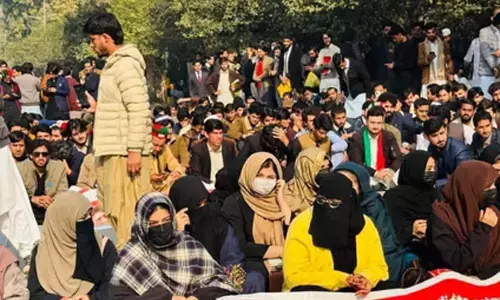How Atal Bihari Vajpayee Won Friends, Influenced Allies And Came To Power

The BJP rode on former prime minister Atal Bihari Vajpayee s larger than the party image and avuncular manners to win over new allies and back to back victories in Lok Sabha elections in 1998 and 1999 to become a dominant force, eclipsing the Congress for the first time
Never the one who wore the BJP's core Hindutva ideology on his sleeve, Atal Bihari Vajpayee led the party from 1980 to 1986, but with little electoral success.
NEW DELHI: The BJP rode on former prime minister Atal Bihari Vajpayee's larger than the party image and avuncular manners to win over new allies and back to back victories in Lok Sabha elections in 1998 and 1999 to become a dominant force, eclipsing the Congress for the first time.
Never the one who wore the party's core Hindutva ideology on his sleeve, the poet-politician led the party from 1980, when it was founded by leaders of the erstwhile Jana Sangh which was merged with Janata Party briefly, to 1986 but with little electoral success as it won only two seats in the 1984 Lok Sabha elections.
However, it was LK Advani who was at the centre of the BJP's rise through the late 80s and early 90s as it rode the Ram Janmbhoomi movement pushed by its Hindutva affiliates like the Vishwa Hindu Parishad and fuelled by 'rath yatra' in 1990 in support of a temple in Ayodhya.
Veteran journalist Radhika Ramaneshan recalls that Atal Bihari Vajpayee propounded the idea of "Gandhian socialism" that found little traction with the masses and he was virtually "sidelined" in the organisation as the Rashtriya Swayamsevak Sangh, the BJP's ideological parent, decided that the party must go full throttle on Hindutva.
LK Advani, always seen as a more hardcore ideologue than Atal Bihari Vajpayee, took over as the party president in 1986 as the organisation decided to throw its weight behind the 'Ram Janmabhoomi' movement and for the first time adopted a resolution in its national executive in 1989 in favour of a temple at the disputed site in Ayodhya.
"Atal ji was kind of marginalised in this whole phase. The story of the BJP really begins from that (Ram temple movement) and he was not present in that phase. He was ideologically very strong but he would not wear it on his jacket, and not chant slogans to prove his pro-Hindutva credentials," Radhika Ramaneshan says.
Atal Bihari Vajpayee was not really the party's mascot during the huge political success of the temple movement as it bounced back strongly in 1989 with 85 seats from the low of two in 1984 and then became the principal opposition party in 1991 with 120 seats.
Though LK Advani's Hindutva push fuelled the party's massive growth from a relatively low base, it was increasingly felt within the organisation and also sections of the RSS that if it has to go to the next level and realise its dream of forming a government, then it needed a face whose appeal rose beyond its ideological call.
Atal Bihari Vajpayee, who was seen as a peace-maker capable of taking everybody along, was the perfect fit for such a leader, she says.
Party veterans said that 90s were an era of coalition politics and the BJP was almost a pariah for regional parties, especially from southern India, outside its traditional partners like Shiv Sena and Akali Dal, following the demolition of Babri mosque in 1992.
It was then that in 1995, a year before Lok Sabha elections, that the party, then led by LK Advani, projected Atal Bihari Vajpayee as its prime ministerial candidate, a view also endorsed by the then RSS chief Rajendra Singh, better known as 'Rajju Bhaiyya'.
If LK Advani's ideological leadership galvanised the party's cadres and core support, Atal Bihari Vajpayee soaring oratory, common touch and easy charm won over the masses.
Critics of BJP would often allege that Atal Bihari Vajpayee was just a 'mask' to cover the party's hardline agenda.
But there was no denying that he was a true people's leader whose mass appeal cut across divides of caste, language, region and also religion.
He led the party to its best ever tally, until then, of 161 in 1996 but his government fell after merely 13 days. However, an unstable coalition government resulted in another poll in 1998.
By that time, more and more allies were willing to fall to the appeal of his personable aura and agreeable leadership and he led a government for 13 months before it fell after his Tamil Nadu ally and AIADMK chief Jayalalithaa withdrew her party's support.
But he was not to be denied a full term at the centre and led a much stronger coalition to power in 1999.
Such was his pan India appeal in the late 1990s than even in states like Andhra Pradesh and Tamil Nadu, BJP's allies gained from it.
















